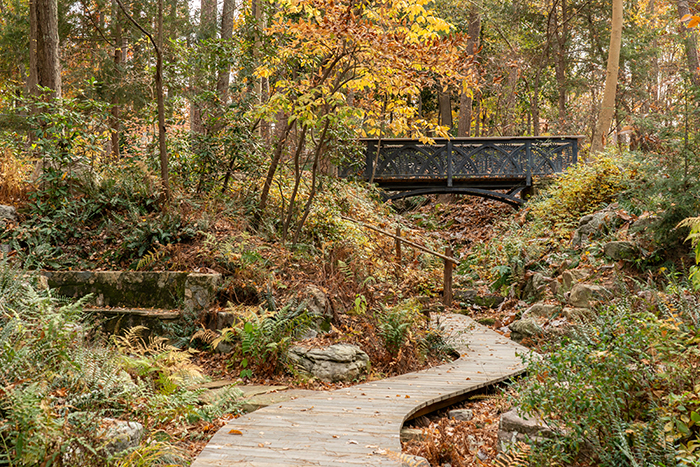
Wooden boardwalk in the ravine in the Blomquist Garden of Native Plants, by Clarence Burke.
The best explanation I’ve ever heard for why you shouldn’t walk in plant beds was from a teacher on a field trip to a small organic farm. “Do you wear shoes in bed?” the teacher asked her students as they studied the rows of vegetables together.
“No!” the kids shouted, shaking their head in unison.
“Well, the same is true for these beds, so don’t walk in them,” the teacher said, and she was absolutely right.
Although it seems hard and solid on the surface, the ideal soil is actually light and fluffy on a microscopic level, allowing air and water to easily infiltrate. Putting any amount of weight on the soil crushes these tiny gaps, resulting in a hardened, thickened material that farmers, gardeners and horticulturists call “compacted soil” and avoid at all costs because it’s difficult to grow anything in it.
Even if the soil initially starts out fine, soils slowly or abruptly compacted over time inevitably result in the slow, lingering deaths of the plants that are deprived of the water and air they need to thrive. This is why you’ll see reams of orange fencing labeled “Tree Protection Area” around many construction sites, so the heavy machinery doesn’t compact the soil around the remaining trees and inadvertently kill them. This is also why people working by hand might lay down wooden boards to stand on in order to spread and distribute their weight as much as possible and prevent any further compaction.
However, the best way to deal with soil compaction is to avoid it in the first place—to refrain from standing in any garden beds or other sensitive areas where plants are growing, and instead stay on marked paths whenever possible. Even a few steps can add up over time, especially when multiplied by the 600,000 visitors Duke Gardens welcomes every year.
Soil compaction is such a big deal—especially in grassy spaces like the South Lawn and other areas with high levels of foot traffic, such as behind the Doris Duke Center—that horticulturists have developed special aeration tools that poke holes in the soil, allowing it to “breathe” without the disruption to the turfgrass root systems caused by more aggressive tillage. This is also why the beds with high turnovers, such as in the Terrace Gardens and the Charlotte Brody Discovery Garden, are regularly tilled to make the soils light and fluffy, while more permanent plantings elsewhere are left as undisturbed as possible once established. Wooden boardwalks in some areas of the the Blomquist Garden of Native Plants allow visitors to move through the landscape while minimizing their impact on the soil below.
It’s important to point out that soil compaction isn’t always a bad thing. It’s an essential part of any construction process, in order to be sure that anything built on site will remain stable over time. And many compaction tools are built explicitly to facilitate this process. The dam separating the pond in the Culberson Asiatic Arboretum from the Historic Gardens depends on the strength of packed earth in order to function, and human beings throughout history have created mounds, barrows, forts and shelters composed mostly or entirely out of compacted local soils.
However, the same traits that make soil ideal for a solid and dependable structure make it less good for growing plants and trees, which have to work harder in order for their roots to penetrate compacted soil. This is why laying out paths is one of the most important parts of any successful garden design—and why it’s important to respect them as much as possible, in order to ensure the wellbeing of individual plants and the landscape as a whole.
